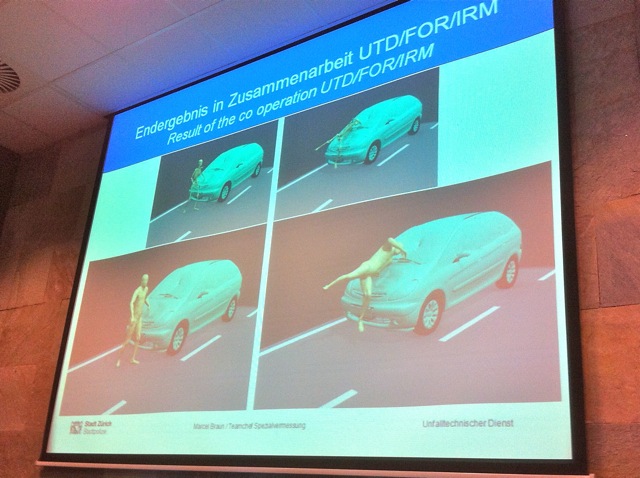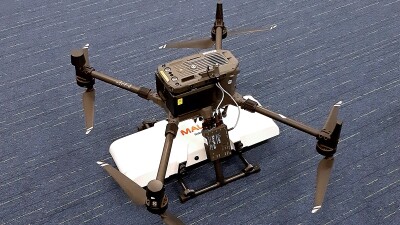Today wasn’t really the proper first day of SPAR Europe, but even if the keynotes kick off tomorrow morning, there was plenty of progressive technology use on display today to keep one interested. I spent much of the day in the forensics track, and I’ve got to say I was more than a little impressed with the way the forensics community is pushing the technological envelope.
I’ve got thousands of words of notes on the matter, but they’re threatening to kick me out of the only decent place to get wired internet in the World Forum, so I’ll focus on three small pieces of presentations that really got me thinking:
1. Of course someone scanned that hanging crane: One of the most indelible images from hurricane Sandy was that overturned crane that threatened passersby on the street in downtown Manhattan. Well, that was a job for a laser scanner, and Jim Wiethorn, principal engineer and chairman of the board at Haag Engineering, was the guy to do it, along with colleague Chris Zmijewski (I actually had a go at spelling that off the top of my head, but it was pointless to try). They weaseled their way to the roof of the building across the street, pulled out their HDS 7000 and got some great data. Here’s Jim presenting it:

In the end, he said the crane was taken down relatively safely (which disappointed the local news media, he noted) and this particular example wasn’t necessarily the one where he demonstrated how laser scanning really proved its mettle, but it was still pretty cool to see laser scanning play a role in such a major news event – I should have thought of this, really, when I was writing up my ideas for how lidar could help in the Sandy clean-up.
Where laser scanning really does help, said Wiethorn, is in the recreations he does to provide evidence on the witness stand. He’s got more than 125 trials under his belt, and he said laser scanning allows him to prepare evidence in two days that used to take “several months.” That’s a nice efficiency boost.
2. Forensic investigators are combining 3D technologies like nobody’s business: Marcel Braun of the Zurich Police (with help from translator Jorg Meixner) provided a fascinating look at how he’s using CT scan technology to scan bodies that have been in fatal accidents to create bone structure models, and then layer muscle and skin, so that simulations can be performed to determine how the accident actually occurred in coordination with the medical department at the University of Zurich.
The list of hardware and software he’s using would make your head spin. Here’s a look at what the accident modeling looks like:

Obviously, this kind of high-level modeling and animation can only be done for the most high-profile cases, as it must be massively time consuming, but it’s impressive to see this kind of technology being applied in real life and not just on some TV show.
3. Did someone say “drones”? It’s really gratifying to see some of the hot topics that have been going across the SPAR pages show up in real-life applications. Today, Christophe Lambert and Pascal Lamusse of the French Gendarmerie showed some work they’d been doing with a quad rotor drone taking photographs that were then turned into a model in 123D Catch. Here’s the drone they’re using:

I don’t think this is something they’re breaking out every day, by any means, but they clearly see a use for rapidly modeling accident scenes and they said they’re alright with 8-10 cm accuracy (which is better than I thought they’d be able to get, actually, judging by my experience with 123D Catch). While the Gatewing, Sensefly, and other wing-style UAVs clearly have their applications, I can see the helicopter-style drones being much more popular in the short term if they become more commercialized. Finding take-off and landing spaces isn’t always easy or practical and sometimes you just want to be 50 feet up or so, not necessarily 100 meters-plus.
So, there are three cutting-edge applications in forensics I picked up here on day one. I’ve got a ton more examples, but you’ll just have to stay tuned for more.





